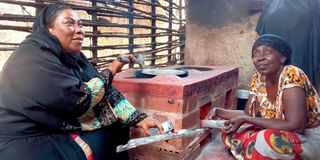Lamu women smiling all the way to the kitchen after receiving improved jikos

Bibi Yusuf (left) and Sofia Shee using the improved cook stove at Matondoni Village, Lamu West. Wetlands International in coordination with the CFA has introduced the improved cook stoves to reduce pressure on mangrove forests in the region.
What you need to know:
- Sofia Shee has used the traditional three-stone method to cook family meals for decades.
- Smoke from the stove has exposed her and many other women to smoke-related ailments.
- Wetlands International and Lamu Community Forest Association delivered the women from the smoke menace by donating improved cooking stoves to more than 2,000 households.
For decades, Sofia Shee has used the traditional three-stone method to cook family meals.
The 50-year-old resident of Matondoni Village in Lamu West, admits that the smoke from this cooking method, which involves the use of mangrove fuelwood, has exposed her to many ailments.
She says the prolonged exposure to the wood smoke, on a daily basis, is directly associated with the increased occurrences of respiratory and other ailments among the women of Matondoni Village.
Things, however, seem to have changed for the better, given what nation.africa observes during a visit to the remote island of Matondoni. The women look happy.
Wetlands International, an organisation dedicated to the conservation and restoration of wetlands, and Lamu Community Forest Association (CFA) came together to deliver the women from the smoke menace by donating improved cooking stoves to more than 2,000 households.
Like many communities residing in the Coast region, Lamu’s community relies on fuel wood as the primary source of energy, a practice that degrades mangrove forests and terrestrial vegetation.
The improved stoves minimize exposure to smoke-related ailments and eases pressure on mangrove fuel.
Ms Shee is happy that the cook stoves also use less fuel wood and reduces the time to prepare meals.
“I used to go to the hospital almost weekly, if not daily, suffering from eye and respiratory complications. I am happy that the recently provided cook stoves have solved such issues. They are smokeless and save much of our time when cooking,” says Ms Shee.
Kibibi Yusuf, a beneficiary, says the stoves are durable, easy to ignite, have good heat retention, and easy to maintain.
“In the past, I would take more than four hours just to cook a meal using the three stones stove. Since I received the improved jiko, it takes me only two hours to prepare food. The cost of fuel wood has also reduced. These improved stoves use only one or two pieces of firewood, not a whole bunch,” says Ms Yusuf, adding that the stoves produce less smoke.
Swabra Musa says she enjoys using the stove because her children can now accompany her to the kitchen without fear of being exposed to smoke.

Ephantus Wamae, the engineer in charge of installing the improved jikos. He says the cook stoves are multi-purpose, user-friendly and cook faster.
Speaking at Matondoni when they distributed the improved stoves, Wetlands International Regional Programmes Officer Lilian Nyaega, said small-scale energy systems like the invented cook stoves, not only reduce threats to mangroves, but also contribute to the achievement of the Nationally Determined Contributions.
She said mangroves are part and parcel of the Lamu community because they rely on them for food, wood fuel, livelihoods and house construction, among other services.
“We’re working with the Lamu community to provide improved cook stoves to as many households that reside proximate to mangrove forests, as possible. This is an effort to minimize the overuse of mangroves for fuelwood. Remember, firewood consumption is one of the key causes of mangrove degradation in Kenya,” said Ms Nyaega.
Shawlet Cherono, the Lamu Wetlands International Project Officer, lauded the Lamu women for embracing the initiative, saying it will reduce the usage of firewood and subsequently improve conservation and protection of the mangrove forest cover in the county.
A recent report on the State of Mangroves in the Western Indian Ocean released by Wetlands International, the total area of mangroves in Kenya decreased from 54,990 hectares in 1996 to 53,852 hectares in 2016, representing an overall net loss of 1,139 hectares, which is equal to two per cent over the last 20 years.
“We also plan to introduce the same in Kipungani and Mkunumbi in the near future,” said Ms Cherono.
Ephantus Wamae, the engineer in charge of installation of the improved cook stoves said the jikos were user-friendly and multi-purpose, as it uses all sizes of sufurias, and one can use either firewood or charcoal to cook.
Mr Wamae said while making the jikos, he applies the rocket-principle.
“I make something like a chamber enclosing gas under pressure. I then leave a small opening at one end of the chamber to allow the gas to escape, and in doing so, provides a thrust that propels the smoke, which is ignited and produced or emitted as heat. I fix the jikos with a ceramic liner to ensure the heat is conserved during cooking,” said Mr Wamae.





